Thermal Textile Pixels: The Characterisation of Temporal and Spatial Thermal Development
Abstract
:1. Introduction
1.1. Thermal Communication
1.2. Thermal Expression
1.3. Defining Thermal Textile Pixel
2. Results
2.1. Thermal Conductivity
2.2. Mapping Temporal Thermal Development, Out-of-Plane
2.3. Mapping Thermal Spatial Development, In-Plane
3. Discussion
4. Materials and Methods
4.1. Textile Materials
4.2. Characterisation of Thermal Conductivity
4.3. Characterisation of Heat Source
4.4. Characterisation of Temporal Thermal Development, Out-of-Plane
4.5. Characterisation of Spatial Thermal Development, In-Plane
Author Contributions
Funding
Conflicts of Interest
References
- Berger, X.; Sari, H. A new dynamic clothing model. Part 1: Heat and mass transfers. Int. J. Therm. Sci. 2000, 39, 673–683. [Google Scholar] [CrossRef]
- Karaca, E.; Kahraman, N.; Omeroglu, S.; Becerir, B. Effects of Fiber Cross Sectional Shape and Weave Pattern on Thermal Comfort Properties of Polyester Woven Fabrics. Fibres. Text. East. Eur. 2012, 92, 67–72. [Google Scholar]
- Marolleau, A.; Salaun, F.; Dupont, D.; Gidik, H.; Ducept, S. Influence of textile properties on thermal comfort. In IOP Conference Series: Materials Science and Engineering 254, Proceedings of the 17th World Textile Conference AUTEX 2017-Textiles-Shaping the Future, Corfu, Greece, 29–31 May 2017; IOP Publishing: Bristol, UK, 2017. [Google Scholar]
- Song, G. 2—Thermal insulation properties of textiles and clothing. In Textiles for Cold Weather Apparel; Williams, J.T., Ed.; Woodhead Publishing: Cambridge, UK, 2009; pp. 19–32. [Google Scholar]
- Lenz. Available online: https://www.lenzproducts.com/de/heating-wear.html (accessed on 10 October 2018).
- Inuheat. 2018. Available online: https://inuheat.com (accessed on 9 October 2018).
- Embr Labs. Available online: https://embrlabs.com (accessed on 10 October 2018).
- Fujita, H.; Nishimoto, K. Lovelet: A Heartwarming Communication Tool for Intimate People by Constantly Conveying Situation Data. In Proceedings of the CHI 2004, Vienna, Austria, 24–29 April 2004. [Google Scholar]
- SUITCEYES. Available online: https://suitceyes.eu/ (accessed on 12 September 2019).
- Wilson, G.; Halvey, M.; Brewster, S.; Hughes, S. Some like it hot? Thermal feedback for mobile devices. In Proceedings of the CHI ’11 CHI Conference on Human Factors in Computing Systems, Vancouver, BC, Canada, 7–12 May 2011; pp. 2555–2564. [Google Scholar]
- Lee, W.; Lim, Y. Explorative research on the heat as an expression medium: Focused on interpersonal communication. Pers. Ubiquit. Comput. 2012, 16, 1039–1049. [Google Scholar] [CrossRef]
- Lee, W.; Lim, Y. Thermo-Message: Exploring the potential of heat as a modality of peripheral expression. In Proceedings of the CHI 2010, Atlanta, GA, USA, 14–15 April 2010. [Google Scholar]
- Hossler, F. Ultrastructure Atlas of Human Tissues; John Wiley and Sons, Incorporated: Somerset, UK, 2014. [Google Scholar]
- McGlone, F.; Reilly, D. The cutaneous sensory system. Neurosci. Biobehav. Rev. 2010, 34, 148–159. [Google Scholar] [CrossRef] [PubMed]
- Møller, A.R. Physiological Pain. In Sensory Systems: Anatomy and Physiology, 2nd ed.; Aage R Møller Publishing: Dallas, TX, USA, 2012; pp. 342–343. [Google Scholar]
- Jones, L.A.; Berris, M. The psychophysics of temperature perception and thermal-interface design. In Proceedings of the 10th Symposium on Haptic Interfaces for Virtual Environment and Teleoperator Systems, Orlando, FL, USA, 24–25 March 2002; pp. 137–142. [Google Scholar]
- Kappers, A.M.L.; Plaisier, M. Thermal Perception and Thermal Devices used on Body Parts other than Hand or Face. IEE Trans. Haptics 2019. [Google Scholar] [CrossRef] [PubMed]
- Manasrah, A.; Crane, N.; Guldiken, R.; Reed, K.B. Perceived Cooling Using Asymmetrically-Applied Hot and Cold Stimuli. IEEE Trans. Haptics 2017, 10, 75–83. [Google Scholar] [CrossRef] [PubMed]
- Hojatmadani, M.; Reed, K. Asymmetric Cooling and Heating Perception; Springer: Cham, Switzerland, 2018; pp. 221–233. [Google Scholar]
- Oron-Gilad, T.; Salzer, Y.; Ronen, A. Thermoelectric Tactile Display Based on the Thermal Grill Illusion. In Haptics: Perception, Devices and Scenarios; Springer: Berlin/Heidelberg, Germany, 2008; pp. 343–348. [Google Scholar]
- Peterson, J. Trikåteknik, 6:e upplagan; Textile Support Scandinavia: Borås, Sweden, 2013; p. 1. [Google Scholar]
- Baxter, S. The thermal conductivity of textiles. Proc. Phys. Soc. 1946, 58, 105–118. [Google Scholar] [CrossRef]
- International Organization of Standardization. Textiles—Determination of Thermal Resistance (ISO 5085-1:2004); International Organisation for Standardization: Geneva, Switzerland, 2004. [Google Scholar]
- International Organization of Standardization. Textiles—Determination of Thickness of Textiles and Textile Products (ISO 5084:1996); International Organisation for Standardization: Geneva, Switzerland, 1996. [Google Scholar]
- Elektrokit.com. Available online: https://www.electrokit.com/en/ (accessed on 20 April 2018).
- FLIR Tools+|FLIR Systems. Available online: https://www.flir.de/products/flir-tools-plus/ (accessed on 24 April 2018).



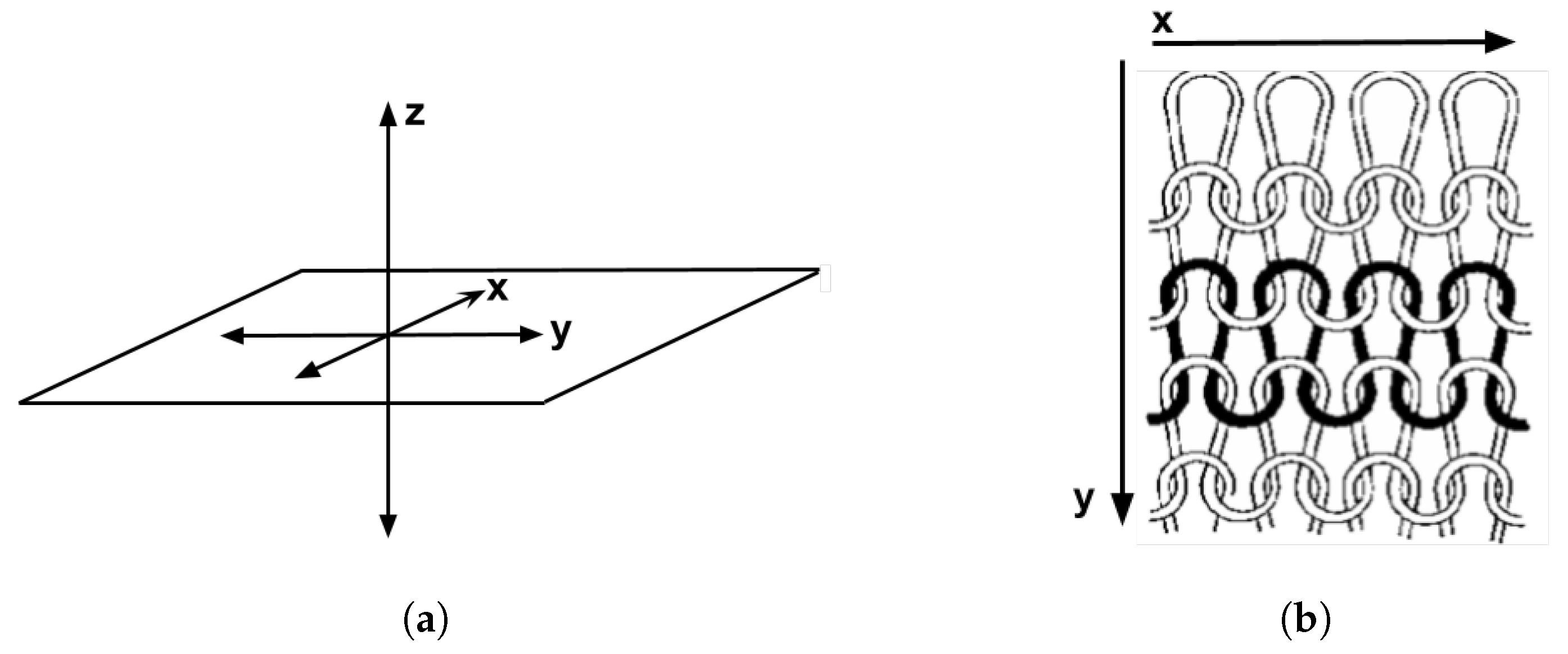


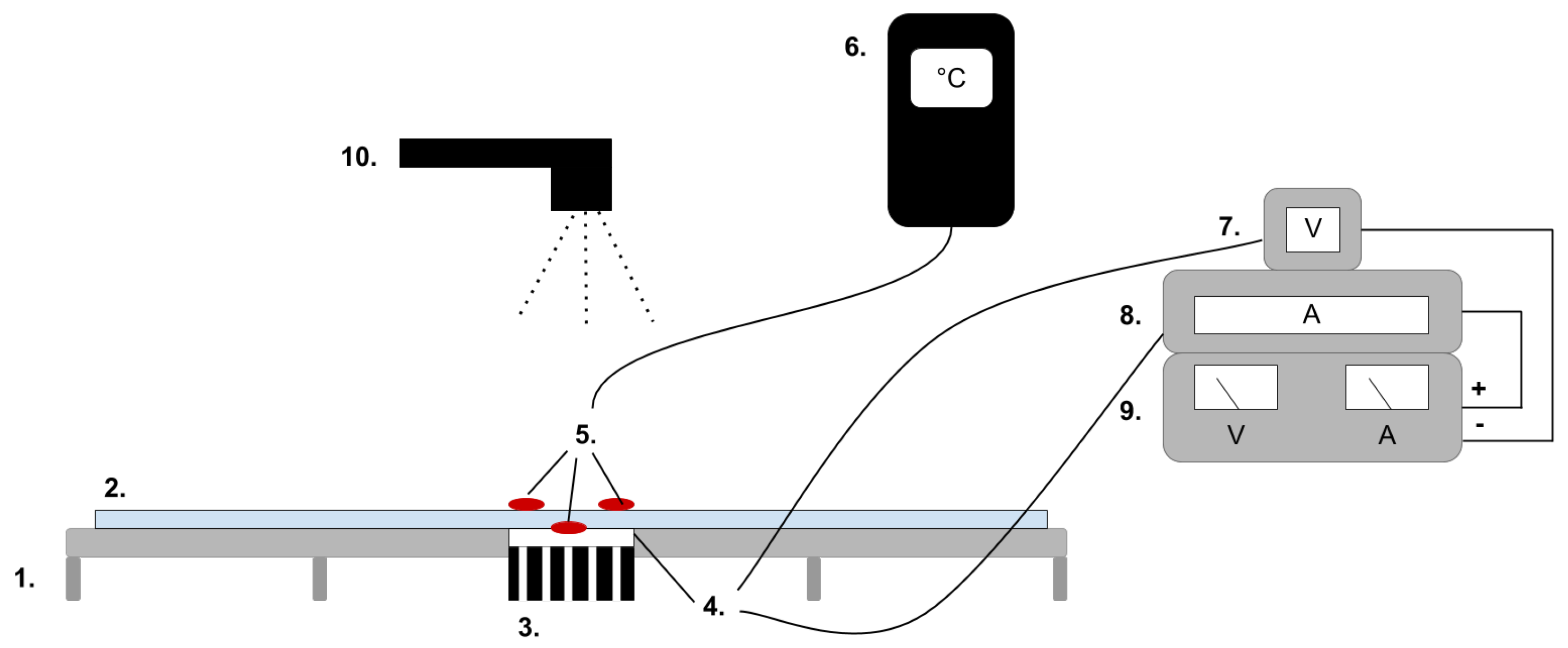

| Structure | Material | Mass per Unit Area [g/m] | Thickness (20 Pa) [mm] | StDv | Air Flow Resistivity (Face) Pa·s/m | StDv | Thermal Resistance [mK/W] | Thermal Conductivity [W/(m·K)] |
|---|---|---|---|---|---|---|---|---|
| Plain | Shieldex | 239.83 | 1.56 | ±0.07 | 49.82 | ±1.62 | 0.015 | 0.10 |
| PA | 261.96 | 2.01 | ±0.18 | 171.4 | ±1.14 | 0.024 | 0.08 | |
| WO | 524.05 | 3.41 | ±0.13 | 79.24 | ±2.67 | 0.104 | 0.03 | |
| Terry | Shieldex/PA | 273.58 | 3.03 | ±0.13 | 78.8 | ±1.22 | 0.044 | 0.07 |
| PA | 354.22 | 3.02 | ±0.08 | 165.4 | ±0.89 | 0.035 | 0.09 | |
| WO/PA | 441.52 | 4.47 | ±0.03 | 71.34 | ±1.39 | 0.119 | 0.04 |
| Heating | Active Cooling |
|---|---|
| plain knit | |
| Shieldex | |
 (a) |  (b) |
| wool | |
 (c) |  (d) |
| polyamide | |
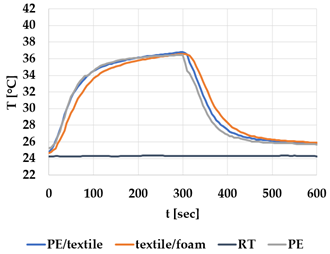 (e) | 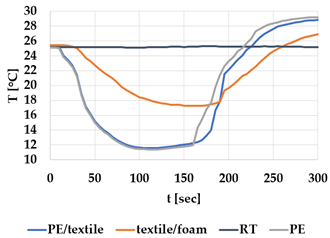 (f) |
| Heating | Active Cooling |
|---|---|
| terry knit | |
| Shieldex/PA | |
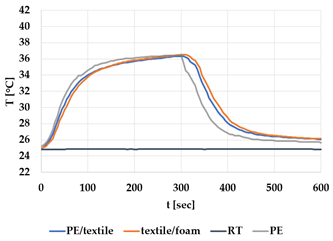 (a) | 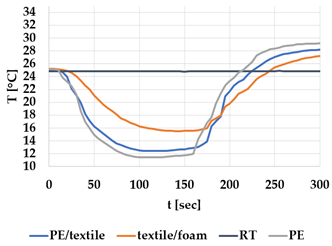 (b) |
| wool/PA | |
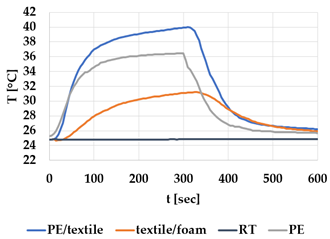 (c) |  (d) |
| polyamide | |
 (e) | 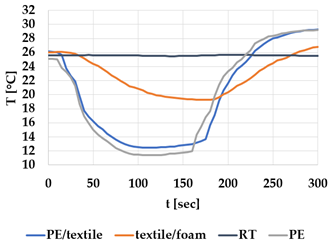 (f) |
| Heating | ||
|---|---|---|
| plain Shieldex | plain polyamide | plain wool |
 (a) | 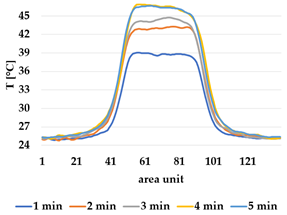 (c) | 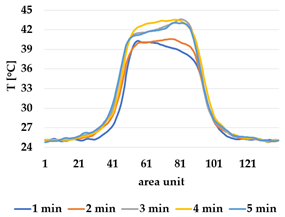 (e) |
| Active Cooling | ||
| plain Shieldex | plain polyamide | plain wool |
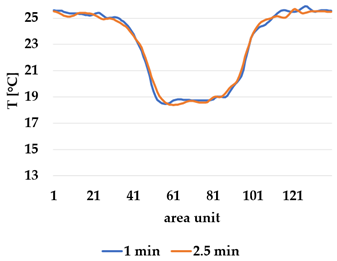 (b) | 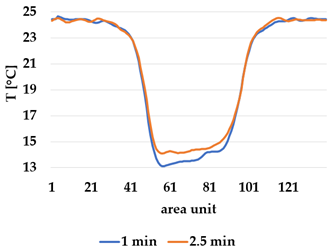 (d) |  (f) |
| Heating | ||
|---|---|---|
| terry Shieldex/polyamide | terry polyamide | terry wool/polyamide |
 (a) |  (c) |  (e) |
| Active Cooling | ||
| terry Shieldex/polyamide | terry polyamide | terry wool/polyamide |
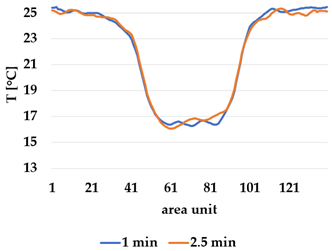 (b) |  (d) |  (f) |
| Heating | Active Cooling |
|---|---|
| Terry Shieldex/polyamide | |
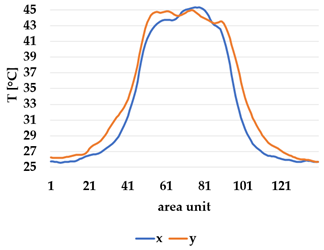 (a) |  (b) |
© 2019 by the authors. Licensee MDPI, Basel, Switzerland. This article is an open access article distributed under the terms and conditions of the Creative Commons Attribution (CC BY) license (http://creativecommons.org/licenses/by/4.0/).
Share and Cite
Stöhr, A.; Lindell, E.; Guo, L.; Persson, N.-K. Thermal Textile Pixels: The Characterisation of Temporal and Spatial Thermal Development. Materials 2019, 12, 3747. https://doi.org/10.3390/ma12223747
Stöhr A, Lindell E, Guo L, Persson N-K. Thermal Textile Pixels: The Characterisation of Temporal and Spatial Thermal Development. Materials. 2019; 12(22):3747. https://doi.org/10.3390/ma12223747
Chicago/Turabian StyleStöhr, Adriana, Eva Lindell, Li Guo, and Nils-Krister Persson. 2019. "Thermal Textile Pixels: The Characterisation of Temporal and Spatial Thermal Development" Materials 12, no. 22: 3747. https://doi.org/10.3390/ma12223747
APA StyleStöhr, A., Lindell, E., Guo, L., & Persson, N. -K. (2019). Thermal Textile Pixels: The Characterisation of Temporal and Spatial Thermal Development. Materials, 12(22), 3747. https://doi.org/10.3390/ma12223747




